Replacing pipes in the toilet from A to Z: design, selection of building materials, installation work + error analysis
It is not easy, but possible, to replace leaky pipelines in the toilet room on your own. The main problems here arise due to the constraint in the bathroom. Many owners do not want to get rid of the old toilet, and replacing the pipes in the toilet with the plumbing already installed is still a pleasure.
We will tell you all about the rules and the specifics of replacing communications in the bathroom. We will show you what material you need to stock up on an independent home master. In the article we presented, the replacement technology is described in detail, useful recommendations are given, the observance of which will ensure the build quality.
The content of the article:
Pipe diagnostics
Before you go to the store to buy new pipes, you need to once again think about whether such repairs should be done at all and in what volumes it should be made. If you plan to work in the toilet, which is located in a private house, then this is one situation. Here, the master master does not hurt.
But when working in a high-rise apartment, there will be many problems. When replacing risers in the apartment it is necessary to coordinate their actions with neighbors in advance. And this is not only a tribute. There are several points, forgetting about which, for a short time to face serious problems.
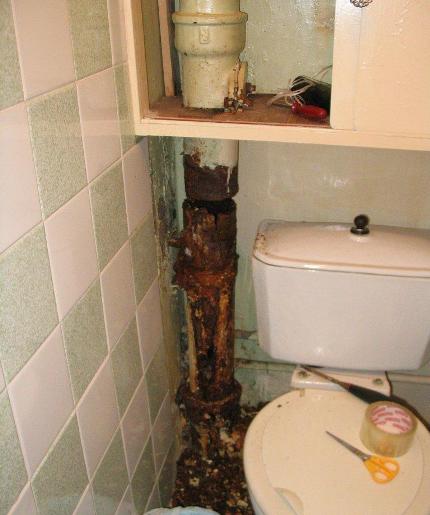
First, water pipes can be blocked in the basement of the entrance for several hours without asking anyone. In the afternoon, plumbing blocks of flats do this quite often. Neighbors at work during the day, most of them do not even know about a break in the water supply. However, it is not worth dismantling the sewer riser without warning.
Even if you turn off cold water in the house, it still remains in the tank of the toilet. And with the dismantled sewer riser, all the fecal masses that will be washed off on the floors above will certainly be in your toilet.
It is better to communicate with neighbors in advance and warn them about the work being done so that they do not use plumbing for a couple of hours. The second point is the pipes on the site in the floor. These risers are considered the most vulnerable and the most problematic. This is where metal rusts the fastest.
With the complete replacement of pipelines, they must be led out from above and below through reinforced concrete. That is, welding and other connection of new pipes with old ones may have to be performed in neighboring apartments one floor higher and lower.
Having learned about the repair, the neighbors may well decide to change the risers at the same time with you. This will save a little on the material and the call of locksmiths who will come to block the water in the basement for the duration of the repair.
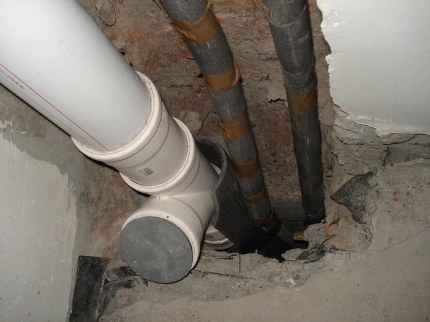
The third point is the condition of the pipes. Often, plumbing and sewer risers look useless just outside. But when cutting an old iron pipeline, there are frequent cases when it is covered with rust only on the outside.
If it does not flow, then it is often not worth replacing it. Inside, everything can be perfect for him, the walls are still quite capable of lasting a couple of decades.
This happens when bad ventilation in the bathroom and toilet. Condensation builds up on metal conduits from the outside, causing rust. However, corrosion affects only the outer surface of the pipeline. Then it only needs to be cleaned with a sandpaper and painted with good paint.
Changing pipes in such a situation is just wasting money. Replacing the cast-iron riser of a sewage system with a plastic one should be done at all with its external destruction. Old cast iron is more durable and less “noisy” than modern plastic.
Options for laying pipes in the bathroom
If the toilet in the apartment or cottage is not combined with the bathroom, then special problems with the preparation of the layout of pipelines are unlikely to arise. As a rule, there is only one toilet bowl in it and there are two risers, from which it is necessary to bring a couple of pipes to this only plumbing fixture.
However, next to the wall there is usually also a kitchen and a bathroom, where pipelines are also required. But with their wiring, basically, there are difficulties when replacing pipes.
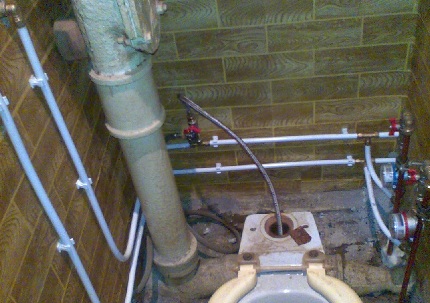
There are two technologies for laying pipes in the bathroom:
- Outdoor.
- Hidden.
The first method is simpler to execute, and the second is more aesthetically pleasing. With hidden laying of pipelines, you will have to ditch the walls, and this is dirt and extra time for preparation.
The best option is to lay the pipes in the toilet according to the external scheme, and then cover them with a decorative box. Moreover, you still have to close the risers with decor. If you leave them open, then the interior of the bathroom will look ugly.
With a hidden gasket, any leakage subsequently immediately turns into a headache. We have to start all over again. You will have to remove the lining, break the walls and change the pipes again.
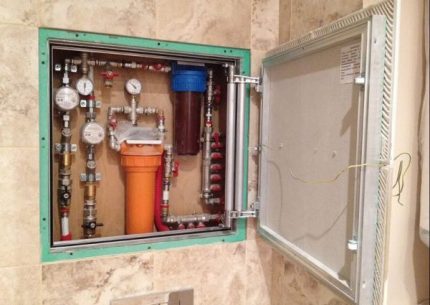
Sewer pipe is laid with a slope to the riser to ensure gravity flow. According to the rules pipe routing in bathrooms at the places of installation of plumbing fixtures, tees are inserted into it with the location of the bells towards the movement of drains.
By building codes sewer pipe slope is selected based on the diameter of the pipeline. The smaller the cross section, the more the latter should be tilted.
For an intra-house sewer pipe with a diameter of up to 50 mm, the slope is 3 degrees (3 cm in height for each running meter). For products with a cross section of 50-110 mm, it is recommended at 2 degrees, and for analogues in 110-160 mm - at the level of 0.8 degrees.
Plumbing is connected to the water supply:
- in a sequential manner;
- through the collector at the riser.
The collector option is more expensive, but the pressure on each water outlet with such a wiring is always the same. In this case, the water pressure in the taps and the shower does not skip when the washing machine is turned on or the toilet bowl is full.
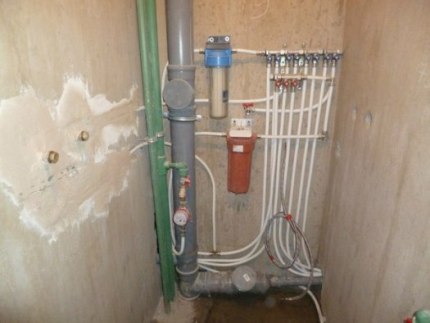
Water sockets are attached directly to the walls or to traverses (metal plates with holes for fasteners). In this case, the tap for the toilet in the toilet is easiest to do with a hose.
On a conducting water pipe with a cold water supply, a tee insert is simply made with an output having an external or internal thread. Ideally, pipes everywhere should be mounted in parallel, without intersecting with each other.

From the riser, the water supply is first set ball valve, then the coarse filter, and only then the counter. The simplest and cheapest filter is a mechanical one without backwashing (with a small direct or oblique “process”, with a dirt sieve inside).
On it, from time to time it will be necessary to unscrew the lid with a wrench to wash the stainless steel mesh that accumulates sand and rust. The auto-wash filter is large. It must be connected to the sewage system, and a bypass bypass must be installed in parallel with it.
If there is not enough space on the toilet wall, then it is better to refuse this option. All this in a complex is called an “input node”. After it there is already a pipe for connecting plumbing or a collector.
Procurement of building materials
There is no ideal building material. In each case, their own option is selected, the most suitable for specific conditions.
When replacing pipelines in a toilet, it is necessary to purchase the pipes themselves, fittings and taps for them in advance. It does not hurt to design in advance camouflage box and purchase finishing materials for him. Then all the work will take a maximum of one day.
Sewer pipe selection
With sewer pipes, the easiest way. If the existing cast-iron riser does not have cracks and holes, then you should not change it. Otherwise, it is worth choosing plastic tees and bends.
These tubular products are light in weight and easy to install. Their connection with each other is made into a bell having a rubber cuff. The most difficult thing is to cut such pipes with a hacksaw into a segment of the desired length, not forgetting to process the end from burrs.
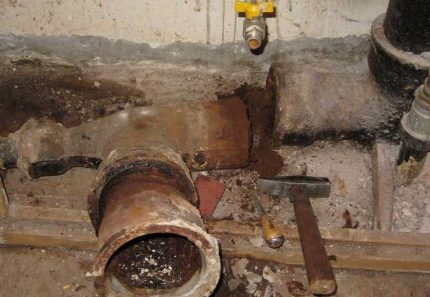
For installation in the toilet are sold polymer sewer pipes of:
- PVC
- Polypropylene.
- Polyethylene.
The cheapest option is polyvinyl chloride. But polyethylene and polypropylene are more resistant to household chemicals and temperature extremes that occur when draining hot water into the sewer. However, in general, any of these materials is suitable for a toilet in an apartment and a private house.
Previously, cast-iron pipes were connected with cement or sulfur. In the first case, the joint will have to slowly be cracked up with a screwdriver, and in the second - to be heated with a burner.
One element should be removed from the other carefully by loosening back and forth, otherwise the bell will crack and it will be necessary to change the pipes much more.For the connection of plastic and cast iron, an appropriate size of the rubber cuff will be sufficient.
Types of pipes for domestic hot water and cold water systems
Water pipes for replacement in the toilet can be taken:
- stainless steel;
- copper;
- polypropylene;
- polyethylene;
- polyvinyl chloride;
- metal-plastic.
Steel and copper pipes will have to be connected by welding (soldering), so they are rarely taken for self-assembly. Stainless steel is often used by locksmiths to replace old iron risers.
This option is the most reliable. The joints of new and old sections of such a pipe with high-quality welding almost never leak.
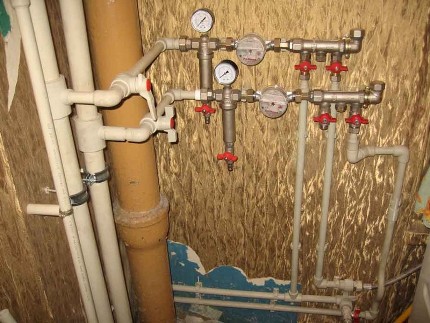
For cold water in the apartment, plastic pipes should be purchased with the PN10 marking. This thin-walled version is designed for a working pressure of 1 MPa and a water temperature of up to +200C. For the HVS this is enough. For DHW, an analogue with PN20 and higher is required. It has thicker walls and higher operating parameters for temperature and pressure.
Pipes PP (PP) are connected by diffusion welding using fittings and butt. The connection is one-piece. For the installation of metal-plastic compression or press fittings are used. This is the simplest material for self-assembly of the pipeline. Plus, if necessary, the water conduit can easily be disassembled to replace or insert new plumbing.
PVC are mounted on glue by butt or fitting connection. PE (PND) at home are connected by electrofusion welding or compression couplings.
Metal-plastic pipes are good at the possibility of bending in the corners of the room, they are the most plastic of all analogues from plastic. However, fittings are expensive for them. Polypropylene water pipes are cheaper to connect, but because of the large thermal expansion, they often sag on hot water. PVC is cheap, but to supply hot water you have to choose another option.
How not to make a mistake when dismantling / installing pipes
When planning the replacement of pipes in the toilet, it should be remembered that the matter is not limited to one room with a toilet. The sewer pipe will have to be completely replaced exactly.
Separately changing sections of the water supply only in the toilet, without affecting the areas in the bathroom and kitchen, is also hardly a reasonable undertaking. If you update the pipes, then immediately completely from the riser to all, without exception, plumbing devices.
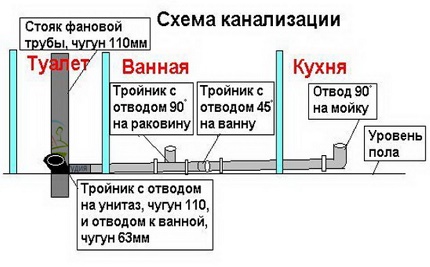
Separate cast-iron tees and insert new plastic bends into them exclusively by rotational movements. Cast iron is too fragile to press hard on it, much less hit it with a heavy tool. But if such a riser is planned to be completely removed, then it will not be difficult to break it into separate pieces.
All existing flexible sleeves in a braidgoing to the mixer or to the toilet should be thrown out immediately upon dismantling. Their service life usually does not exceed five years.
It’s better not to hesitate to exchange them for new ones. A similar situation with all the old valves. If she has served more than 3-4 years, then replacement is required. It’s not worth the risk.
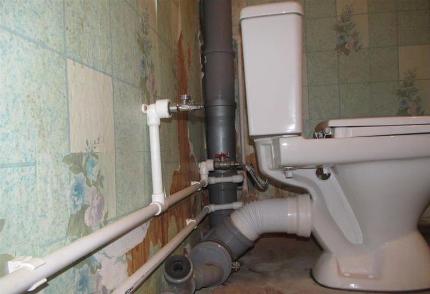
Shaped parts must not be trimmed or modified in any way. The bell should look towards the movement of wastewater.
Without exception, all water pipes must end with stopcocks. Ideally, before each plumbing device, its own fittings with ball locking are necessary. This will greatly simplify life in the future with connecting and replacing appliances in the bathroom and kitchen.
Before close pipes, you should test the system. It is necessary to supply water through all pipelines and turn on all plumbing fixtures. And then you need to check the joints for leaks and leaks. Only in the event of their complete absence can you start finishing the toilet.
Conclusions and useful video on the topic
To make it easier for you to understand all the nuances of replacing pipes, we have made a selection of video materials explaining all the subtleties and tricks of the process.
Video # 1. How not to change pipes and plumbing:
Video # 2. All about the proper installation of the internal sewage system:
Video # 3. The tricks of replacing metal pipes with plastic in the combined bathroom are:
Replacing old sewage and water pipes in the toilet is easy. There are some subtleties in this work, but if you want, you can do everything yourself.
Only before dismantling the existing risers, it is worth taking a closer look at them. Old pipelines are often able to serve for many more years. This is especially true of the sewer system.
Want to talk about how to change communications in your own bathroom? Do you have valuable information that may be useful to site visitors who want to change pipes on their own? Please write comments in the block below, publish your photos, ask questions about controversial issues.

 Soldering polypropylene pipes: work rules and analysis of possible errors
Soldering polypropylene pipes: work rules and analysis of possible errors 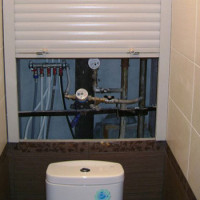 How to arrange a pipe box in the toilet: an overview of the best ways to mask the pipeline
How to arrange a pipe box in the toilet: an overview of the best ways to mask the pipeline 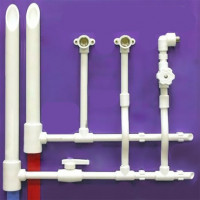 Installation of a water supply system from polypropylene pipes: typical wiring diagrams + installation features
Installation of a water supply system from polypropylene pipes: typical wiring diagrams + installation features 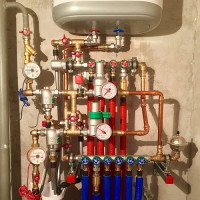 Piping in the bathroom: analysis of hidden and open piping schemes
Piping in the bathroom: analysis of hidden and open piping schemes 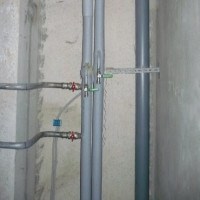 Replacing Bathroom Tubes: A Step-by-Step Guide to Work
Replacing Bathroom Tubes: A Step-by-Step Guide to Work 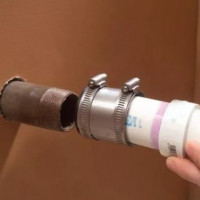 The connection of plastic pipes with metal: an analysis of the best methods and mounting nuances
The connection of plastic pipes with metal: an analysis of the best methods and mounting nuances  How much does it cost to connect gas to a private house: the price of organizing gas supply
How much does it cost to connect gas to a private house: the price of organizing gas supply  The best washing machines with dryer: model rating and customer tips
The best washing machines with dryer: model rating and customer tips  What is the color temperature of light and the nuances of choosing the temperature of the lamps to suit your needs
What is the color temperature of light and the nuances of choosing the temperature of the lamps to suit your needs  Replacement of a geyser in an apartment: replacement paperwork + basic norms and requirements
Replacement of a geyser in an apartment: replacement paperwork + basic norms and requirements
Heh, to protect sanitary ware (toilet) from damage when replacing pipes in the toilet - this is just the easiest in all the work described above. We simply ask the owners for old and unnecessary rags: blankets, coats, jackets. Something we may bring with us. For example, I always carry a Soviet cotton blanket. Wrap up, and all things. Even if the hammer falls, protection usually works. It is only necessary to discuss this moment in advance, so that the owners prepared these same rags. The drain tank, if the toilet does not have a monoblock toilet, can be easily removed. Remains the cup, and wrap it.
Much more problems are usually with neighbors. Not everyone wants a repairing neighbor to bring the ends of a new sewer riser to them and, accordingly, the connecting seams remain in their apartment, while the neighbor has a new whole beauty. Human psychology, what to do. There are many who object not because of beauty, but because they are afraid that the junction will flow. And flow, it turns out, in their apartment.
I also came across a request to make a layering for a washing machine in the process of updating the pipes in the toilet. It’s in the toilet, yeah. It was assumed that the machine would stand on a pedestal later laid out of brick, higher than the level of the tank, but behind a person sitting on the toilet. I don’t know if that project was implemented or not, but I remember it very much.
In no case can the sewer riser be changed independently - this should be done by the plumbers of the housing department or the management company, because this is their area of responsibility. Yes, and because if replacement is necessary for technical reasons, then for the owner it will be free.
And yes, it’s better to agree with the neighbors, but if they don’t want the pipe connection to be on their territory, then there is nothing to be done. Because at the junction, a leak may form and this will already be their headache.